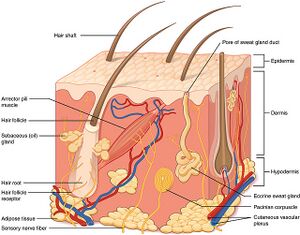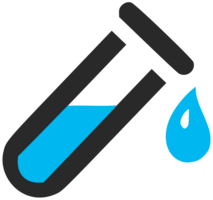Physiology of Sweat
Physiology of sweat[edit | edit source]
Types of Sweat Glands[edit | edit source]
- Eccrine – These are the most distributed throughout the body, and are distributed throughout the entire surface area. They produce the most sweat. There are about 2-4 million glands throughout the body. They are found on both glabrous (palms, soles) and non-glabrous parts of the body. Density of these glands is not uniform throughout the body, as they are the most dense in palms and soles (~250-550 glands/cm2). These are activated by emotional and thermal stimuli. [1]
The density of these glands on non-glabrous skin, like the face, trunk, and limbs, are ~2-5x less than on glabrous skin. These are more variably distributed, and mainly function with temperature regulation. [1]
It is seen that the number of eccrine sweat glands are fixed throughout life, and start developing in infancy. This explains why the density of these glands decrease as a person develops and grows, and their skin expands. This is known to be inversely proportional to body surface area. Therefore children have a greater density of sweat glands than adults, and obese people of any age are seen to have a lower density of eccrine sweat glands. [1]
Despite this, having a greater density of sweat glands does not indicate that the person would sweat more. The differences between sweating rate throughout the body, or different areas of the body, would be due to the sweat secretion rate per gland, compared to the total number of active sweat glands. The contents of eccrine sweat are mainly water and NaCl. It also contains chemicals from interstitial fluid and the eccrine gland. [1]
Eccrine sweat glands can also be thought of as an excretory organ, since they excrete waste products as well. [1]
- Apocrine – These are larger than eccrine glands, and open into hair follicles, instead of being directly on the skin.
Apocrine sweat glands are present in the: axilla, breasts, face, scalp, and perineum.
Similar to the eccrine glands, they are present from birth/childhood, but unlike the eccrine glands they do not start secreting until puberty. Apocrine glands produce viscous, lipid-rich sweat, which consists of proteins, and ammonia. This gland can be known as the scent gland, which is involved in producing pheromones, having an important social and sexual function in humans. [1]
- Apoeccrine – These develop from eccrine sweat glands between the ages of ~8-14 years. They share properties of both eccrine and apocrine glands and are medium in size. These are only found in the axillary region. [1]
They are similar to eccrine glands, as the distal duct connects to and empties sweat onto the surface of the skin, and they produce a large amount of salt water secretions. [1]
Here is a video explaining sweat glands, with some additional information: [2]
Composition of Sweat[edit | edit source]
Although sweat is mainly water and NaCl, there are many other minerals and constituents as a part of its composition. These include: [1]
| Micronutrient | Concentration | Parts of the Body | Sweat Gland Mechanism |
|---|---|---|---|
| Sodium | 10-90mmol/L | Found in many different sites such as forehead, chest, back, upper arm, but not in all individual sites, such as the foot, calf, thigh. | Initial sweat is isotonic with blood plasma – hypotonic sweat is the end result. |
| Chloride | 10-90mmol/L | Found in many different sites such as forehead, chest, back, upper arm, but not in all individual sites, such as the foot, calf, thigh. | Initially a little hypertonic when compared to blood plasma - resulting sweat is hypotonic. |
| Potassium | 2-8mmol/L | Sweat is closely isotonic with blood plasma. |
There are trace amounts of calcium (0.2-2.0 mmol/L), magnesium (0.02-0.4 mmol/L), iron (0.0001-0.03 mmol/L), zinc (0.0001-0.02 mmol/L), and copper (0.0005-0.02 mmol/L). However, regional measures of calcium, magnesium, iron, zinc, and copper, all overestimate the concentration produced throughout the body. [3] Interstitial fluid is the initial constituent for sweat development, thus many of the components released are derived from interstitial fluid itself. Some, not from interstitial fluid, are biproducts of sweat gland metabolism, and play a role in skin health. Other non-mineral components (some harmful, some not harmful) of sweat include: [3]
- Lactate – there is about 5-40mmol/L secreted. It is produced by eccrine sweat gland metabolism.
Interestingly, there is an inverse relationship between sweat rate and the concentration of sweat lactate, however there is a direct relationship between sweat rate and lactate excretion rate. It plays a role as a natural skin moisturizer, in eccrine sweat, and functions to excrete metabolic waste.
- Urea – there is about 4-12mmol/L secreted.
This comes from blood plasma, therefore has a similar concentration. Urea also plays a role as a natural skin moisturizer, in eccrine sweat, and functions to excrete metabolic waste.
- Ethanol – there is about 2-30mmol/L secreted.
This also mainly comes from blood plasma. Ethanol has a role of detoxification in eccrine sweat.
- Ammonia – there is about 1-8mmol/L secreted.
The concentration of ammonia is about 20-50x greater than plasma, and the concentration is inversely related to sweating rate and pH. It mainly comes from plasma NH3. The function of ammonia in eccrine sweat is the excretion of metabolic waste.
- Bicarbonate – there is about 0.5-5.0mmol/L secreted.
There is less concentration of bicarbonate than blood plasma. With HCO3 being reabsorbed in the sweat duct, there is acidification of the sweat output. HCO3 is inversely proportional to sweat rate. Therefore, sweat pH is lower at lower sweat rates. HCO3 is responsible for controlling the pH of eccrine sweat.
- Glucose – there is about 0.01-0.2mmol/L secreted.
This is the main energy source for eccrine sweat gland secretions.
- Heavy Metals (lead) - there is about 0.0002-0.0006mmol/L secreted.
Concentrations are generally higher than plasma, but its secretion is very minute. Its main function is detoxification.
Other minor constituents include: [4]
- Antibodies (e.g. IgG, IgA) and Antimicrobial peptides (e.g. dermcidin, cathelicidin, lactoferrin)
- Other Proteins (e.g. albumin, α-globulin, γ-globulin)
- Cytokines (e.g. Interleukin-1α, 1β, 6, 8, 31, TNFα)
- Amino acids (e.g. pyrrolidone carboxylic acid, urocanic acid, serine, histadine, ornithine, glycine, alanine, aspartic acid, lysine)
- Proteolytic enzymes
- Persistent Organic Pollutants (e.g. organochlorinated pesticides, polychlorinated biphenyls, perfluorinated compounds)
- Other Toxicants (e.g. BPA, phthalate, polybrominated diphenyl ethers), and also cortisol, neuropeptides, bradykinins, cyclic AMP, angiotensins, and histamines.
For more information on sweat contents, see these resources: Characterization of sweat induced with pilocarpine, physical exercise, and collected passively by metabolomic analysis, Metabolomics analysis of human sweat collected after moderate exercise, and The proteomic and metabolomic characterization of exercise induced sweat for human performance monitoring: A pilot investigation.
Here is a brief
- ↑ 1.0 1.1 1.2 1.3 1.4 1.5 1.6 1.7 1.8 Baker Lindsay B. Physiology of sweat gland function: The roles of sweating and sweat composition in human health. Temperature. 2019:6(3):211-259.
- ↑ Know The Science. Types of Sweat Glands and their Functions. Available from: https://www.youtube.com/watch?v=Qq46UIGbxxs&ab_channel=KnowTheScience (accessed 24 June 2022).
- ↑ 3.0 3.1 Baker Lindsay B. Physiology of sweat gland function: The roles of sweating and sweat composition in human health. Temperature. 2019:6(3):211-259.
- ↑ Baker Lindsay B. Physiology of sweat gland function: The roles of sweating and sweat composition in human health. Temperature. 2019:6(3):211-259.








